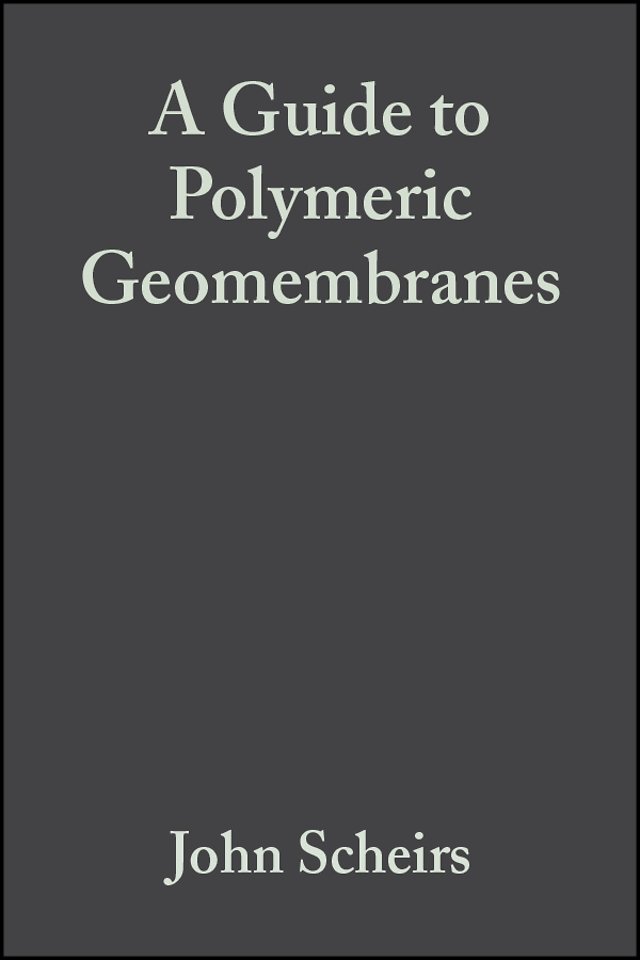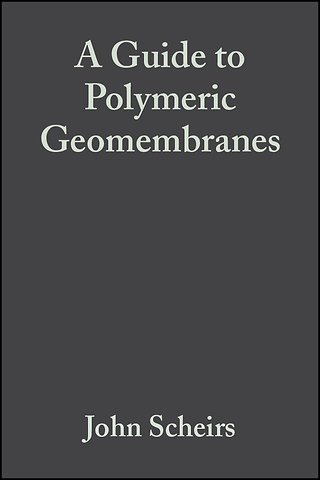A Guide to Polymeric Geomembranes
A Practical Approach
Samenvatting
Geomembranes are flexible polymeric sheets which are used as relatively impermeable liners to contain liquid and vapour. With uses ranging from canal liners to hazard waste landfills, they are used extensively in a range of industries such as water conservation, mining, construction and waste management.
A Guide to Polymeric Geomembranes: A Practical Approach offers an informed overview of the developments in this field and includes:
Detailed discussion of the major geomembrane types
Manufacturing methods
Key performance properties
Industrial applications
Testing and chemical resistance of geomembranes
Failure analysis methodology
Written by a polymer research specialist with more than fifteen years experience in industry, this practical handbook covers the manufacture, use, installation, durability, lifespan and performance of geomembranes. It covers all the information required to enable the reader to select the most suitable geomembrane material for the job.
This book is a useful reference for engineers and professionals in industry, environmental consultants, polymer and materials scientists, and government agencies and policy makers. It is of particular interest to those designing, commissioning and operating waste management sites, landfills, mine leachate ponds and water containment facilities.
Specificaties
Inhoudsopgave
<p>Preface xix</p>
<p>About the Author xxi</p>
<p>Acknowledgments xxiii</p>
<p>1 Introduction to Polymeric Geomembranes 1</p>
<p>1.1 Introduction 1</p>
<p>1.2 Viscoelastic Behaviour 2</p>
<p>1.3 Polymer Structure 4</p>
<p>1.4 Molecular Weight 5</p>
<p>1.5 Molecular Weight Distribution 7</p>
<p>1.6 Crystallinity 8</p>
<p>1.7 Properties of Polyethylenes 14</p>
<p>1.8 Stress Strain Behaviour of Polymers 16</p>
<p>1.9 Melting Points 20</p>
<p>References 20</p>
<p>2 Geomembrane Manufacturing Methods 21</p>
<p>2.1 Blown Film (Round Die) 22</p>
<p>2.2 Flat Sheet Extrusion (Flat Die) 23</p>
<p>2.3 Coextrusion 25</p>
<p>2.4 Calendering 28</p>
<p>2.5 Spread Coating 29</p>
<p>2.6 Extrusion Coated Geomembranes 30</p>
<p>2.7 Pin–Hole Detection 30</p>
<p>2.8 Texturing 30</p>
<p>2.9 Additives for Geomembranes 40</p>
<p>References 51</p>
<p>3 HDPE Geomembranes 53</p>
<p>3.1 Introduction 53</p>
<p>3.2 Structure Property Relationships 59</p>
<p>3.3 Comparison of HDPE Geomembranes with Other Geomembranes 60</p>
<p>3.4 Durability and Survivability of HDPE 60</p>
<p>3.5 Selection of Quality HDPE Geomembranes 63</p>
<p>3.6 Common Failure Modes of HDPE Geomembranes 75</p>
<p>3.7 Multilayer HDPE Geomembranes 77</p>
<p>3.8 Fluorinated HDPE (F–HDPE) 82</p>
<p>References 88</p>
<p>4 Linear Low–Density Polyethylene Geomembranes 91</p>
<p>4.1 Introduction 91</p>
<p>4.2 Attributes of LLDPE Geomembranes 92</p>
<p>4.3 Limitations of LLDPE Geomembranes 92</p>
<p>4.4 Mechanical Properties 92</p>
<p>4.5 LLDPE Geomembrane Resins 94</p>
<p>4.6 Speciality Flexible Polyethylene Geomembranes 95</p>
<p>4.7 Very Low–Density Polyethylene (VLDPE) Geomembranes 100</p>
<p>References 100</p>
<p>5 Flexible Polypropylene (fPP) Geomembranes 101</p>
<p>5.1 Introduction 101</p>
<p>5.2 Attributes of fPP Geomembranes 102</p>
<p>5.3 Shortcomings of fPP Geomembranes 102</p>
<p>5.4 Performance Propeties of fPP Geomembranes 104</p>
<p>5.5 Applications 112</p>
<p>5.6 fPP Field Failures 112</p>
<p>References 115</p>
<p>6 CSPE Geomembranes 117</p>
<p>6.1 Introduction 117</p>
<p>6.2 Grades of Hypalon J n117</p>
<p>6.3 Attributes of CSPE Geomembranes 118</p>
<p>6.4 Limitations of CSPE Geomembranes 119</p>
<p>6.5 General Properties of CSPE Geomembranes 120</p>
<p>6.6 Comparisons of CSPE with Other Geomembranes 125</p>
<p>6.7 Applications of CSPE Geomembranes 125</p>
<p>6.8 Chemical Resistance of CSPE Geomembranes 125</p>
<p>References 126</p>
<p>7 PVC Geomembranes 127</p>
<p>7.1 Introduction 127</p>
<p>7.2 Attributes of PVC Geomembranes 130</p>
<p>7.3 Shortcomings of PVC 132</p>
<p>7.4 Properties of PVC Geomembranes 133</p>
<p>7.5 Failure Modes 134</p>
<p>7.6 Formulation of PVC Geomembranes 136</p>
<p>References 138</p>
<p>8 EIA Geomembranes 139</p>
<p>8.1 Introduction 139</p>
<p>8.2 Attributes of EIA–R Geomembranes 141</p>
<p>8.3 Limitations of EIA–R Geomembranes 142</p>
<p>8.4 Performance Properties of EIA–R Geomembranes 142</p>
<p>8.5 Comparison of EIA–R (XR–5 —) Versus CSPE–R (Hypalon ) Geomembranes 147</p>
<p>8.6 Application Areas for EIA–R Geomembranes 147</p>
<p>References 148</p>
<p>9 EPDM Geomembranes 149</p>
<p>9.1 Introduction 149</p>
<p>9.2 Attributes of EPDM Geomembranes 149</p>
<p>9.3 Structure and Chemistry 151</p>
<p>9.4 Mechanical Properties 152</p>
<p>9.5 Advantages of EPDM over HDPE Geomembranes (Property Comparison) 153</p>
<p>9.6 Comparison between EPDM and PVC Geomembranes 158</p>
<p>9.7 Seaming EPDM Geomembranes 160</p>
<p>9.8 Applications 161</p>
<p>9.9 Service Life 161</p>
<p>References 162</p>
<p>10 Bituminous Geomembranes (BGMs) 163</p>
<p>10.1 Introduction 163</p>
<p>10.2 Prefabricated Bitumen Membranes 163</p>
<p>10.3 Composition and Construction 164</p>
<p>10.4 Longevity of Bituminous Geomembranes 165</p>
<p>10.5 Spray–in–Place Bitumen Membranes166</p>
<p>10.6 Design Life of Bituminous Geomembranes 167</p>
<p>References 167</p>
<p>11 Specialty Geomembranes and Liners 169</p>
<p>11.1 EVA Liners/Geomembranes 169</p>
<p>11.2 Butyl Rubber Liners 170</p>
<p>11.3 Nitrile Rubber Geomembranes 172</p>
<p>11.4 Chlorinated Polyethylene (CPE) 175</p>
<p>11.5 Polyurethane (PU) Geomembranes 176</p>
<p>11.6 Acrylic–Coated Geomembranes/Geotextile Composites 178</p>
<p>11.7 PVDF Liners 180</p>
<p>11.8 Chemical Vapour Barrier Membranes 182</p>
<p>References 187</p>
<p>12 Key Performance Properties of Geomembranes 189</p>
<p>12.1 Specific Gravity (Density) 189</p>
<p>12.2 Mass per Unit Area 191</p>
<p>12.3 Thickness 192</p>
<p>12.4 Melting Point 196</p>
<p>12.5 Melt Flow Index 198</p>
<p>12.6 Thermal Expansion 199</p>
<p>12.7 Flexibility 203</p>
<p>12.8 Conformability for Intimate Contact 204</p>
<p>12.9 Ability to Resist/Accept Stress and Deformation 204</p>
<p>12.10 Tensile Properties 206</p>
<p>12.11 Puncture Resistance 213</p>
<p>12.12 Tear Resistance 217</p>
<p>12.13 Ply Adhesion of Reinforced Geomembranes 219</p>
<p>12.14 Resistance to Stress Cracking 220</p>
<p>12.15 Frictional Properties 226</p>
<p>12.16 Low–Temperature Properties 232</p>
<p>12.17 High–Temperature Capabilities 236</p>
<p>12.18 Oxidative Resistance 236</p>
<p>12.19 UV Resistance 240</p>
<p>12.20 Permeability of Geomembranes 241</p>
<p>12.21 Durability 245</p>
<p>12.22 Application Specific Performance Properties 249</p>
<p>12.23 Comparison of Performance Properties of Flexible Geomembranes 251</p>
<p>References 251</p>
<p>13 Testing of Geomembranes 255</p>
<p>13.1 Material Property Testing 255</p>
<p>13.2 Measuring Thickness 256</p>
<p>13.3 Density 258</p>
<p>13.4 Mass per Unit Area 259</p>
<p>13.5 Tensile Testing Methods 259</p>
<p>13.6 Tear Testing 266</p>
<p>13.7 Ply Adhesion 268</p>
<p>13.8 Puncture Resistance 269</p>
<p>13.9 Impact Resistance 275</p>
<p>13.10 Environmental Stress Cracking 276</p>
<p>13.11 Dimensional Stability 283</p>
<p>13.12 Friction Angles 284</p>
<p>13.13 Melt Flow Index (MFI) 284</p>
<p>13.14 Durability Testing 286</p>
<p>13.15 Tests for Additives 294</p>
<p>13.16 Carbonyl Index Measurements 303</p>
<p>13.17 Chemical Resistance Testing 305</p>
<p>References 309</p>
<p>14 Chemical Resistance of Geomembranes 313</p>
<p>14.1 Chemical Resistance Tables 314</p>
<p>14.2 Factors Affecting Chemical Resistance 315</p>
<p>14.3 Effects of Chemicals on Geomembranes 322</p>
<p>14.4 Chemical Resistance Testing 322</p>
<p>14.5 Geomembrane Chemical Resistance by Chemical Class 329</p>
<p>14.6 Geomembrane Chemical Resistance by Polymer Type 335</p>
<p>14.7 Environmental Stress Cracking 339</p>
<p>References 341</p>
<p>15 Failure Modes of Geomembranes 343</p>
<p>15.1 Potential for Geomembrane Damage 343</p>
<p>15.2 Failure of Installed Geomembranes 344</p>
<p>References 368</p>
<p>16 Application Areas for Geomembranes 371</p>
<p>16.1 Landfill Liners 371</p>
<p>16.1.1 Design Aspects 373</p>
<p>16.2 Landfill Caps/Covers 374</p>
<p>16.3 Mining Applications 378</p>
<p>16.4 Floating Covers 386</p>
<p>16.5 Tank Liners 394</p>
<p>References 399</p>
<p>17 Welding of Geomembranes 401</p>
<p>17.1 Wedge Welding 401</p>
<p>17.2 Hot Air Fusion Welding 413</p>
<p>17.3 Extrusion Welding 415</p>
<p>17.4 General Overview of Thermal Welding Methods 424</p>
<p>17.5 Potential Thermal Welding Problems 425</p>
<p>17.6 Defects that can Affect Weld Integrity 429</p>
<p>17.7 Trial Welds and Field Welds 437</p>
<p>17.8 Chemical Welding of Geomembranes 440</p>
<p>17.9 General Welding Instructions for HDPE/LLDPE/fPP Geomembranes 442</p>
<p>17.10 General Welding Instructions for PVC Geomembranes 445</p>
<p>References 447</p>
<p>18 Geomembrane Weld Testing Methods 449</p>
<p>18.1 Introduction to Weld Testing 449</p>
<p>18.2 Visual Inspection of Welds 450</p>
<p>18.3 Nondestructive Seam Tests 453</p>
<p>18.4 Destructive Weld Tests 465</p>
<p>18.5 Forensic Weld Examination 484</p>
<p>18.6 Leak Location Testing 485</p>
<p>References 489</p>
<p>19 Geomembrane Installation Factors 491</p>
<p>19.1 Introduction 491</p>
<p>19.2 Design Considerations 493</p>
<p>19.3 Installation and Damage Considerations 496</p>
<p>References 531</p>
<p>Appendix 1 Glossary 533</p>
<p>References 546</p>
<p>Appendix 2 Geomembrane Test Methods 547</p>
<p>American Society for Testing and Materials 547</p>
<p>Geomembrane (GM) Related Test Methods and Standards from GRI 549</p>
<p>Geomembrane Testing Methods Conversion Table ASTM and ISO 551</p>
<p>Index 553</p>

